How To Repair Window Molding
Welp, we had some rot. Specifically, the trim around one of our exterior windows was rotting away. How tin can y'all tell if window trim is rotting abroad? It feels like a sponge when you poke information technology. Forest is not supposed to resemble a sponge. Since winter is coming (don't laugh, we have embarrassingly short summers!), Mrs. Frugalwoods and I are trying to knock out a few needed projects on the exterior of the ol' Frugalwoods home and this rotted window trim quickly ascended to the peak of the list.
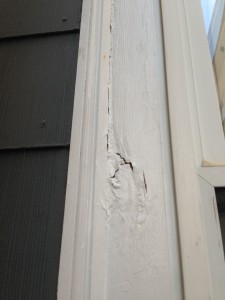
There exist rot! Notice the indentation from my finger. Yeah, that's a bad sign!
Our reasons for replacing it were not entirely cosmetic–rotten window trim can let water infiltrate backside your sheathing (the lath, plywood, or OSB layer underneath your siding). If h2o gets to your capsule, all sorts of bad things happen: mold, rotting insulation, and in the worst cases, rotting framing members.
We're lucky because the window itself is a relatively new vinyl replacement window. Vinyl window are awesomely weather resistant so I knew we didn't have actual window issues. If our windows were wooden frames, we'd likely have a bigger problem on our easily.
Fixing it isn't rocket scientific discipline, but the going local charge per unit for this projection is $350-$500. Knowing that this price is nigh entirely labor, we figured we could practise better, and nosotros did!
Total Cost: $lxxx.33
Supplies:
- Tools:
- Drill / Driver for screwing the trim to the house. We needed to employ screws instead of nails for this project due to the type of trim we were installing. And while a standard cordless drill will do fine for driving screws, an impact driver will freaking alter your life. This is the 1 I have, since it uses the aforementioned battery packs as my drill. I put off this purchase for a long time and I kick myself for doing so.
- Pry bar for pulling apart the existing trim. For the longest fourth dimension I resisted getting a real 1, thinking that I could do but fine with the claws on a hammer. I was dumb. Pry bars are astonishing and I now ain 2 in different sizes. It makes pulling stuff autonomously easier, safer, and less likely to destroy things yous don't intend to destroy.
- Circular Saw for cut the trim to size. Y'all could use a miter saw, or even a hand saw. But, I take a circular saw so that'southward what I used. This projection doesn't need a nice saw, so if yous are in the market feel free to become an affordable model. I'd just recommend one that plugs in rather than taking expensive and brusque-lived batteries.
- Carpenter's square for making direct lines. This is another tool that's easy to ignore, just will make your life easier and more accurate. I have an onetime one from a garage sale (first-class source of tools!) but the standard stanley speed square is a great new option.
- Shop vac for cleaning the area during and after the build. Your neighbors and spouse will give thanks you. Wait for the inexpensive one to go on sale at habitation depot / lowes. Unless yous are using i really heavily… they're all pretty much the same. A handheld "dustbuster" can exist used in a pinch, but clean it out well or you'll be getting yelled at! 🙂
- Measuring record for… I don't need to explicate this, right?
- Consumables:
- Cellular PVC trim. This stuff is magical. Looks like wood, cuts like wood, takes paint like wood… merely information technology's plastic so it won't e'er rot. This is what y'all desire to use if you have to do trim work in wet areas. And if you're replacing previous trim because of rot, then you definitely desire this. It'south more expensive than normal poplar trim, but you'll never have to do the job once more.
- PVC compatible screws. PVC trim is cracking just you need special screws with opposite threads at the top to prevent it from mushrooming out when you drive it in. There are special trim screws for this, but nosotros found the aforementioned thing for less marketed every bit decking screws for composite decks. Might every bit well save a few bucks hither.
- Spray Cream. There is a special kind made for windows and doors that won't expand with enough force to bind the window. The "Smashing Stuff" brand is ubiquitous and just fine.
- Flashing. I used a flexible and gluey asphalt flashing commonly known as "Ice and Water Shield." It'south sold in big rolls for roofs but y'all tin can also find smaller rolls meant for windows.
- Caulk. You want outside UV-rated paintable silicone caulk. The folks in the paint alley tin can bespeak you lot in the right direction from the multitude of caulk tubes. If this is your first time using caulk, you'll also demand a caulk gun. Don't worry, they are inexpensive and sold near the caulk.
How To Supplant Exterior Window Trim
Step i: Demo!
Demolition is my favorite part of any dwelling house improvement project. Zippo like bashing things with hammers to make me smile! For this project through, you'll want to be gentle.
First effort and figure out which trim sections are rotten. Our window had both a apartment board (sometimes called a "brick mold") likewise as a decorative molding. I originally thought information technology was only the brick mold that was rotten, merely it turns out the molding was also getting soft in spots. Poke effectually with a screwdriver and you'll quickly notation which components are in need of repair. If information technology feels similar wood, great! If it feels rubbery or spongy… then it's fourth dimension to tear it out!
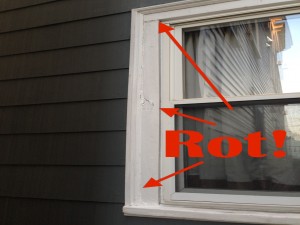
It's Everywhere!
One time you lot've determined which components need to go, use a small pry bar to start removing the pieces. Your goal is to expose plenty of the boards to get accurate measurements. Once you can conspicuously encounter what's where, take a photograph and measure the dimensions. If you tin can keep the trim pieces from falling autonomously every bit yous demo, it volition make cutting your new pieces to fit all that much easier.
Now end removing all trim boards and pray to the god of old houses that you don't find additional rot as you delve deeper into your wall. If yous do discover rotten sheathing or even framing… so you have bigger problems. Non insurmountable, only too maybe not a weekend project. If that'south the case, then yous should go find another how-to post 🙂
Pace 2: Shop
Now that y'all know the quantity and size of trim boards necessary, head to your local dwelling house store and make a beeline for the construction supplies. Hither's a pro-tip: Most of the pros are pretty nice. If y'all are dislocated, ask the guy in the filthy shirt with giant bulging muscles for advice. Dude will almost always hook y'all up. In our case information technology was a very nice Eastern European gentleman with forearms the size of cantaloupes who explained the effectively details between brands of cellular PVC trim.
Step three: Insulate
It's time to inspect and insulate around the window. If you accept a business firm built in the last 50 years, information technology won't look like this. Modernistic houses employ plywood or OSB (oriented strand board) as their sheathing. Besides being cheap, strong, and non requiring the destruction of one-time growth forests, OSB and plywood too brand for very tight window installs.
Sometime houses like ours accept board sheathing. In add-on to being expensive, weak, and requiring the broad-scale deforestation of most of the U.s.a., lath sheathing tends to be poorly fitted effectually windows. Case in bespeak:
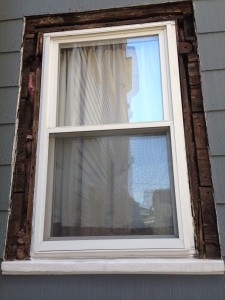
Here's how the window looked without whatsoever trim. Note the boards as sheathing.
At that place's probably a amend style to do this, but wow do I love spray cream. The stuff is magical, especially for filling giant irregular voids.
Four extremely important things to know about spray foam:
- Clothing latex gloves! This stuff is uber gummy. Similar interior of a hot marshmallow sticky. And it'south not expert for your skin. And you lot are most certain to become it all over your hands. Vesture some gloves and you'll give thanks me later.
- Make sure the surface area you'll be foaming is clean. Foam will stick to anything, including the layer of grit and dirt that likely resides around your window. A shop vac makes short work of this.
- Subsequently it's applied, it continues foaming and expanding. Then make sure you lot lay down a thinner layer than you demand and let it expand to make full. You tin can e'er add some more on the 2nd pass.
- In one case y'all break the seal and pull the trigger on the tin of cream there's no stopping. You can't re-use a tin of spray cream and it starts to harden in the tube afterwards almost 15 minutes. Sooner if you don't spray for a few moments. You accept to keep moving and spraying if you lot want to become your coin's worth out of the can.
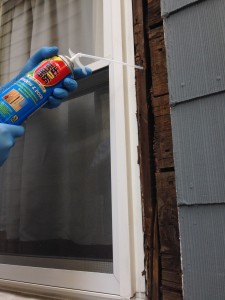
Me to Mrs. Frugalwoods: Take all the photos you lot want Before I start spraying…
And then take a plan! Motility rapidly and evenly use a light layer of cream wherever your voids are deepest. Keep working your way effectually the window filling cracks, voids, holes, and whatever else gets in your mode. In our case, we had behemothic voids to fill. If yous have a newer dwelling house you might only have the area immediately adjacent to the window frame to insulate. In either example, insulation is worth the money while y'all have the window opened up. Might as well do it right.
Afterwards you lot've foamed all in that location is to be foamed (plus some stuff that probably shouldn't have been, but yous know how it goes…) accept a break while the foam hardens. It should exist fine to go on working after 20 minutes or so.
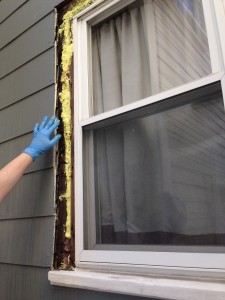
Just look at that nicely foamed (sort of) window opening!
Stride 4: Flash that window!
If your business firm was congenital correctly, you won't need to do this stride as you'll already have flashing. As for us, we needed it.
Flashing a window is a way to seal the area around the window from water infiltration while allowing any water that gets behind the trim boards to leave the wall structure. You can use all manner of materials every bit flashing: plastic, aluminum, lead (yeah, and it works dandy!). Nosotros chose a flexible, sticky asphalt product normally know in the trade as "Ice and Water Guard."
This stuff is really easy to use. Just cutting your pieces to size, pare the backing paper off, and stick it upwardly.
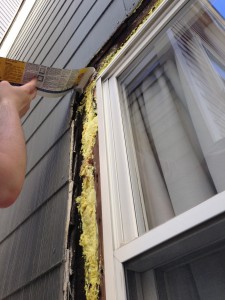
Pro-tip: Don't peel the paper off the flashing until it's in place. This stuff will stick to anything and everything!
Y'all'll want to employ the diverse pieces around the window from bottom to tiptop. That is, you lot want water to be able to travel down the confront of the flashing and never discover an overlapped seam facing upwards. For the top strip of flashing, endeavour to get it as far underneath the layer of siding above as possible. For the flashing on the sides, endeavour to end the flashing on tiptop of the bottom form of siding. This sounds bully in theory, but reality can foreclose information technology from being perfect. Simply endeavour the all-time you can.
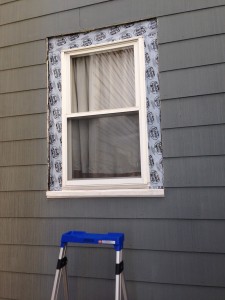
Look at that nicely flashed window!
Footstep 5: Measure and cut trim boards
Now measure for your trim and cutting. I like working from the summit downwardly, but I have no thought if that's actually better.
Our quondam brick mold wasn't mitered in the corners then I followed the pattern and butt jointed it. Yes, I but said butt articulation. It's a carpenter's term, for real. To cutting a straight line with a chop saw or miter saw is simple. If you are making the cutting with a circular saw, depict a directly line on the lath with a carpenter'southward square to brand sure you don't wander. Don't be a cowboy, you and I both know yous can't eyeball it.
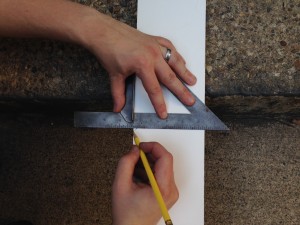
Use your handy peachy carpenter's square to brand a nice correct angle.
While the left side and meridian of the window was a dead ringer for one×5, the right side was juuuust too small for me to wedge it in at that place. Oh the joys of old houses! So I scribed the 1×5 to match the variation in the siding edge and ripped information technology with the circular saw. This I did more often than not eyeball because I knew I would be roofing the crappy edge with the decorative molding. Spiral the boards in place with your nifty special screws (they are actually pretty cracking) and step back and adore how much more like a window information technology looks already!
Step 6: Miter your decorative molding
Unlike your trim board brick mold, decorative molding is pretty ugly in the corners unless you lot cutting information technology on a 45 degree angle–aka a miter joint.
When faced with cut a miter joint, normal folks would go out and buy a miter saw. This makes it really piece of cake to cutting perfect miters every time, but will run you a couple hundred dollars.
If you are like me and a fellow member of team "if it can't be done with a circular saw then you lot shouldn't be doing information technology," and so read on. Cut a 45 degree miter is non much harder than a ninety degree straight cutting. The pull a fast one on is getting a expert line in place, and for that the carpenter's foursquare is essential. Measure out carefully to the outside of the miter (the longest office) and check your marks twice before cutting. Information technology's really piece of cake to get confused and depict your 45 caste line in the wrong direction (ask me how I know this…).
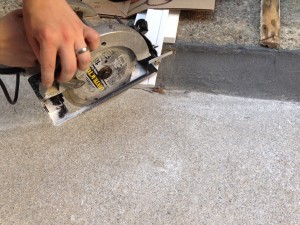
Steady hands and a good line to follow make cutting a miter with a round saw not that bad.
Once y'all have your line in identify, carefully follow it with your circular saw. If you get slowly and cheque your measurements, no ane will ever know yous didn't use a miter saw. Now spiral in your molding and admire your handiwork!
Stride 7: Caulk
Oh you thought you were finished? Not quite. Pause out the caulk and run a bead on all of the joints. Smooth each joint with a moist finger (no joke, the best way to get a skillful caulk line). Don't forget to add together a dab of caulk to each spiral hole as well.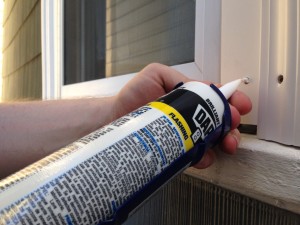
Once the caulk is dry out you can determine whether yous want to paint. So far we haven't, considering the new white trim matches our existing trim pretty well.
Step 8: Victory!
At present you are actually washed. Relish in the celebrity of saving hundred of dollars. Revel in the new conviction yous built in your DIY skills. Or just have a shower. You probably need a shower real bad by now.
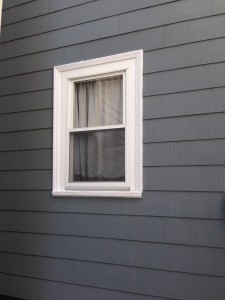
The finished production!
Why do all this?
We're focused on building (hah!) a sustainable life, both from a skills-learning perspective AND from a stable financial perspective.
Our immediate goal is to "retire" early to a homestead in Vermont and leave our urban center jobs behind.
As part of that plan, we've embarked on a journey of radical (sometimes hilarious) frugality. Sometimes information technology'southward trimming a window, other times it's cutting my wife's hair at home (way scarier for me than window trim!)
Desire to know more? Check out our About page to investigate the radical frugality journey so far.
Hope your own window trim projection goes well! Experience gratis to ask questions in the comments — we still read and respond to them even though this post is almost a yr old.
Never Miss A Story
Sign upwardly to get new Frugalwoods stories in your email inbox.
Success!
Source: https://www.frugalwoods.com/2014/07/30/how-to-replace-exterior-window-trim/

0 Response to "How To Repair Window Molding"
Post a Comment